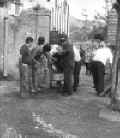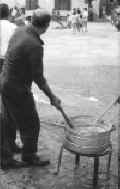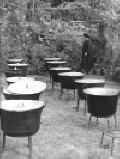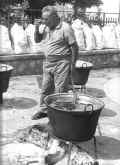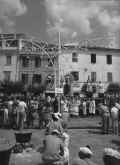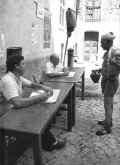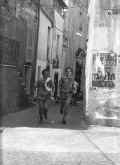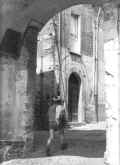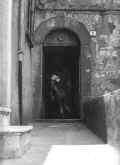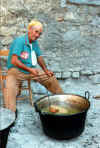Certainly one of the most and old tradition of Ciociaria is "La Panarda" that every year in the 16th of August takes place in Villa Santo Stefano on occasion of festivity of S.Rocco,the patron Saint of the town.
It consists in the cooking and delivery of bread and chickpeas to the people and to the foreign Tourists too. This most important celebration is for the people of our small town a intensive mixture of holy,tradition,remembers and fun.
The preparation, the cooking, the "recipe" and the following delivery are a set rule improved in the time. In the first days of August some women clean around five quintals of chickpeas from earth,then later the "14 Masters of Home" and their "17 Servants" Will immerse these pulses in the boiled water inside coppers feed with oak wood in the main square called Umberto I.
In the heart of the night of 16th of August start the cooking, afterwards at "mezzacottura" have added the old recipe: 100 liters or more of olive oil, pepper and rosemary.
At noon the Archpriest during the procession bless the coppers and the bread, only after this holy rite can begin the delivery of "La Panarda". Then in the church courtyard the "Servants" with their traditional clothes with a pitcher in the hand running to deliver "La Panarda" to all the family of Villa Santo Stefano announced by the "First Master" with own surname or often with the tipical nickname. This operation last some hours. At the end the "Country crier" invite all the people that for mistake or misunderstanding haven’t received the pulses.
The protraction and the intensity of this ancient tradition pressed us to reach the origins and the real spirit of this event. In the forgotten idiom of the Middle Ages in the dangerous time of the soldiers of fortune the world "Panarda, Paggio or Panatica" denoted the military supplies or also the plunder in case of victory in the battle.
Then "Panarda" means plenty and fun for the common people. Successively the "Rural Community" provided with food like bread and pulses to the poor of the village in two different times of the year, the first called "Sfamo" during the cold winter, the second in the summer called "Liberanza". Finally these generous gifts were delivered only in the feast of S.Sebastiano and S.Rocco.
The frequent epidemics and pestilences, often spreaded in Italy by the foreigner forces, induced the medioval religious people to built outside of the wall of the castle small chapels, churchs or aedicules consacrated to the saints to the protection against the plague. Also in our small town exist a church dedicated to S.Sebastiano and S.Rocco,built in the first middle of 15th century, today stands in the heart of town but once was outside of the wall like a sentinel against the infection. His architecture is characteristic with a wooden trabeation or like the tuffaceos portals. In the high altar was a wood painted statue of S.Sebastian and to the sides of the altar there are two large frescos showed a Madonna with angels and Saint George fighting against the dragon. Also interesting the presbitery with two long mansory benchs. The date of the building of the church was curved on a tile of the roof gutter. At the benning this nice construction was consacrated to San Sebastiano later to San Rocco too. In the lunette of the main portal was portrayed the virgin and to her sides are San Giuseppe and San Rocco. The our saint was dressed like a pilgrim with the left hand on the heart and in the right a long stick on wich it was tied a small pumpkin and in the belt had a shell in order to reach the water. It demonstrates that the cult of San Rocco was associated in posterior age towards the end of the 15th century. In fact in the same time the cult of saint have been a great resonance in Italy where he spent his youth. His reputation through the story of the miracolous recoveries from the plague had pushed our population to worship San Rocco. Also therefore the origin of "La Panarda" is tipical of that period of scarcity and pestilence where the "Community" donated in the recurrences of the feasts of the saints a warm meal to the poor composed of bread and pulses. The first testimony of the celebration of "La Panarda" and the relative feast of San Rocco date back to the August 1643 and was annotated in the archives of the town council resolutions where was write in ancient Italian that "…is necessary to buy plates and glasses for the "MAESTRI DELLA CASA" and deliver gifts to the poor….". More later in the 1706 the same council ordered the delivery to the foreigner tourist too.
All the boards that prompthy worked for "La Panarda" improved this fantastic event like a high example of fraternity between Villa S.Stefano and the tourists and the emigrants too.
